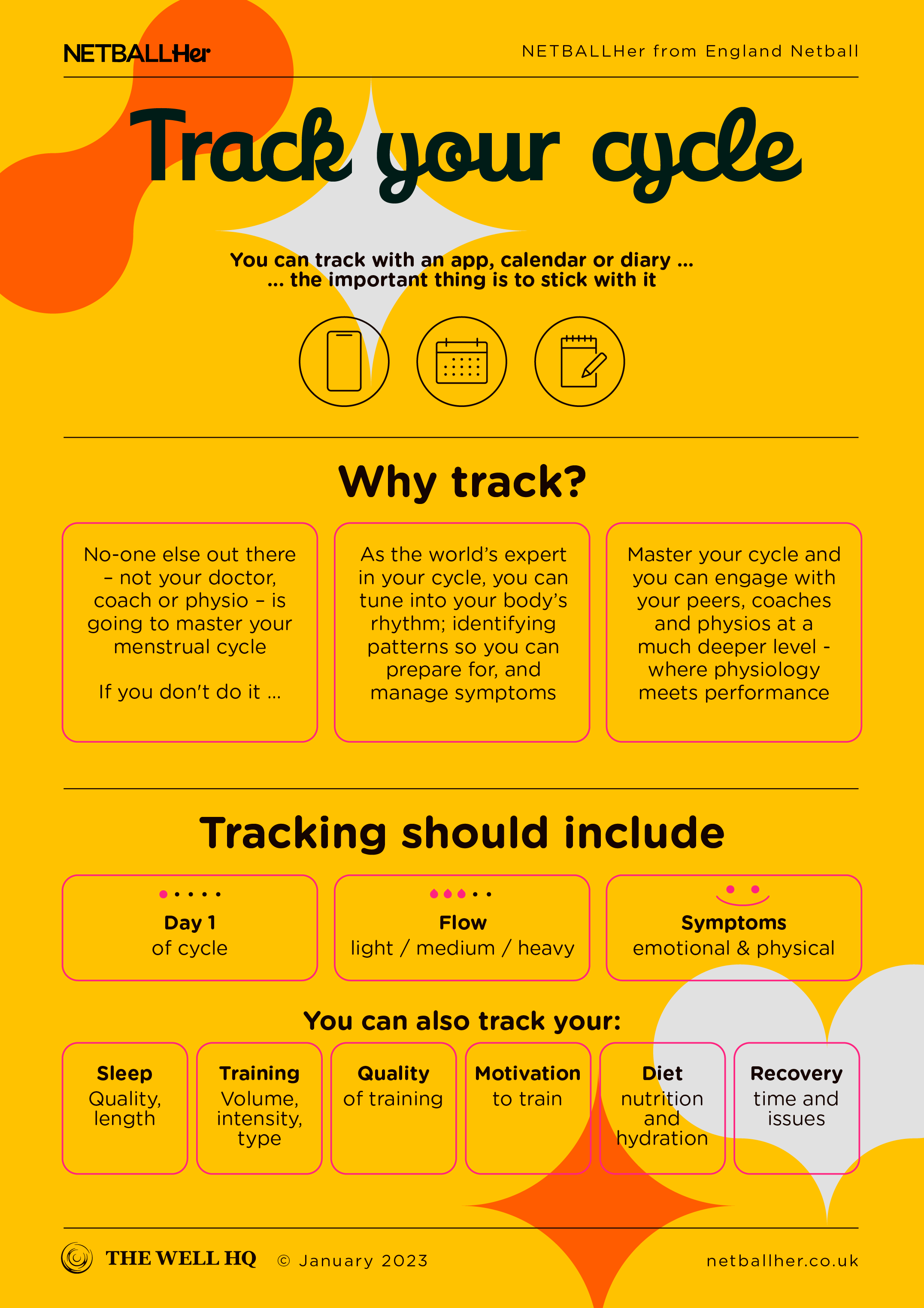Click play for an audio readthrough of this article
Don’t track your menstrual cycle and it can be super easy to miss the dots and where they join. Yes, tracking can seem like yet another thing to do but the effort is massively worth it …
Why track?
- No-one else out there – not your doctor, coach or physio – is going to master your menstrual cycle. Not without your help, anyway. Start tracking and you can unlock new layers of understanding.
- As the expert in your cycle, you’ll be able to tune into and understand your body’s rhythm. For one, you’ll be able to predict and proactively manage your symptoms. And two, you’ll be able to identify energy, recovery and injury patterns and how they relate to your cycle so you can lean into or dial back training accordingly.
- As master of your cycle you’ll be able to engage with your peers, coaches and physios at a deeper level; where physiology meets performance. You can tune in and build a regime that complements your body’s rhythm, and your athletic goals.
It’s just another thing to do
Yes it is. But it doesn’t have to be complicated. Tracking your cycle is an investment: you put time in and get valuable information out. That information, put to work, can power positive change in your menstrual, physical and emotional health. And your performance.
The best way to approach tracking is to understand the end goal(s) and to know that there’s value in it. Keep that mindset: stay curious and open.
Next find a method of tracking that suits you. Keep it simple. There are dozens of apps to help (more in a second), but pen and paper, or a calendar, can be equally effective if that works better for you.
You might begin by rating symptoms out of five or by jotting down notes in a calendar. All are good places to start. The important thing is to try and embed this as a new habit so consistency is key; not least because you’ll need about three months of data to spot the patterns and get a solid understanding of your cycle.
What to track
In the spirit of keep it simple, track the information that’s important to you. A lot of women begin by tracking just their period, and the process often evolves from there.
Your cycle length is a very good indicator of overall health. So let’s say you start by tracking only your period. Here’s an idea of what you’ll learn, and how the process may evolve:
- Track your period and you’ll soon be clued up on your standard cycle length.
- Know your cycle length and you’ll be able to spot irregularities.
- If / when your period is early or late, you can reflect back on any recent changes in your life or lifestyle.
- Say you’ve been more stressed recently; you can proactively address this in the next cycle and see what impact it has on your period’s timing.
- Your tracking may evolve as you log changes in how heavy your period flow is, physical and emotional symptoms that show up, and how severe they are, diet and exercise, caffeine and alcohol consumption, sleep and stress. Do that and you’ll build a detailed picture of things that (could) influence your cycle for better or worse.
In our experience, tracking is addictive … in a good way. You’ll want to note more and more things down in case they’re related to your cycle. And rather than brushing things off you’ll begin to join more dots.
It’s a real test-and learn. A journey of enlightenment and discovery.
App-shopping
Many women nowadays choose to track their menstrual cycle using one of the hundreds of apps now available. A standard question we’re asked at The Well HQ is which app’s best?
Really, there’s no best. We recommend you simply start by finding one that feels easy to use and intuitive. Having said that, here are three important things to keep in mind when app-shopping:
1. Does it let you spot the patterns?
You need to be able to see trends over time if you’re to understand the normal physical and emotional characteristics of your cycle. Once you know your normal, it’s much easier to identify irregularities and make connections between them and life events / changes / stressors. Your app should allow you to look back over previous cycles and see what symptoms happened when. It should also allow you to easily visualise the duration of your cycle and period, and compare it to months past.
If an app’s tracking is unintuitive or second-rate – move on.
2. Does it offer advice?
Some apps claim they offer personalised insights via machine learning or advanced AI, but those buzzwords oversell the reality. No two women’s cycle experiences are the same and tech isn’t yet able to provide individualised advice at the depth or nuance we need. For example, a heavy travel schedule on day 15 and the system might log fatigue as a week two cycle symptom … when in reality you were just knackered after a long day. Similarly, it’s easy to give generic diet advice but if the app doesn’t know what you usually eat and drink then it’s making blind suggestions without the necessary information.
Remember: tech is a tool so you can become the expert … not the other way around.
3. Will it eliminate important real-world conversations?
Some apps promote their ability to share your data, passing digital readings or sharing your cycle ‘dashboard’ with a coach, trainer or partner. This could be valuable but, then again, relying on such a feature too heavily could be counterproductive for two reasons.
- Someone reading only data may miss important nuances.
- Locking the menstrual cycle up in a digital box keeps it shrouded in mystery when we ultimately want it out in the open. They might be awkward at first but face-to-face discussions are vital if we’re to bring menstrual cycles into the light. So use your tracking app as a tool to stimulate deeper conversations that could just benefit others too.
The menstrual cycle isn’t digital, the conversation around it shouldn’t be either.
Do I have to share my data?
Not if you don’t want to. In many ways this is intimate data so to share or not to share is up to you. And because the data is yours, its primary value is to you so you can tune into your body, spot patterns and build your knowledge; confidence; physical health; mental health; resilience; peace-of-mind …
Still, sharing can be useful. Various people, from your partner to your teammates, physio and coach, could all benefit from knowing where you’re at and what you’re feeling.
If your partner has this info, they can tune in to your body and know when you need support, or space, or sleep. A teammate or coach who’s able to tune in can know when to push you harder or hang back. A physio or masseuse who’s able to tune in can work with or around your cycle symptoms for more accuracy in how they approach you.
Sharing your menstrual cycle with your doctor can be particularly useful. When you bring valuable information and patterns to the appointment it can help the GP get to the root of the pain or problem more efficiently.
Ultimately it’s up to you. But we’d also suggest that the menstrual cycle is an untapped resource in sport, and in society in general. The more we share and talk about the menstrual cycle, the less it is shrouded in mystery and the more we normalise it for the next generation of athletes … and for everyone else.
Track it to the max
If you decide, now or later, that tracking is helping you enjoy, plan and get more out of your active life then why not dial it up to 11?
New and emerging technologies can enable more in-depth tracking. For example, ovulation test strips help to indicate when you (will) ovulate so you can prepare the transition between the let’s do this of the follicular phase and the steady-eddie-ness of the luteal phase.
Ovulation test strips vary in their level of sophistication (some are digital) but in essence, you pee on a stick every day from about day seven of your cycle and the stick’s reading picks up the surge in luteinising hormone to indicate ovulation.
Hormone monitoring technology might be new but it already offers some exciting possibilities. Via regular saliva samples (collected at home) it’s possible to get daily insight about what your hormones are doing across your whole cycle. So instead of relying on general-population data, you can view your own personalised hormone charts and connect those patterns to your period symptoms, characteristics and dysfunctions.
When used in conjunction with training and diet information, hormone tracking tools can be a real boon for active women. If your periods have stopped you can ascertain whether the menstrual cycle has been suppressed by an energy deficiency or as a result of physical or emotional stress. Once you know, you can take action and track improvements / changes in your hormone patterns going forward.
If more in-depth cycle tracking looks exciting and enriching to you, our advice is keep an expert practitioner on-hand to help you interpret your data (accurately!) and guide any actions you take.
Tracking notes for netball coaches
It’s unrealistic to think you can tune into all your squad members’ menstrual cycles. You’d drown in the data. So to use tracking to your advantage, we suggest you empower your players (show them how and re-enforce over time) to track their cycles and use insights to develop personal strategies that optimise training and recovery on any given day.
Ahead of each session, why not check in with your players and ask that they report to you their menstrual cycle insights, and you can make notes about what you see when training is underway.
For example, if a player tells you she’s in the luteal phase, and says she’s feeling clumsy, you can record exactly how that manifests on the court, and it gives you valuable context for why she might not be on top form. It also allows you to have a conversation with that player about trying some different strategies in her warm up to make sure she shakes off the clumsiness before she gets into the game.
If you’re part of a performance support team that collects menstrual cycle data from players then here are some potential uses for that data:
- You can screen the team for good menstrual health (a regular cycle with manageable symptoms)
- You can track relationships between players cycles and injuries (and then do something meaningful with that information)
- You can identify players who are suffering from symptoms which impact their training (and work with them to do something about it)
- You can tailor specific warm ups, exercises or activities to help those players who are suffering from symptoms, or indeed those who are feeling extra-good
The key thing is that you use the data, and that you explain to players how you’ll use the data. Transparency and feedback will ensure it’s a healthy, working exchange between you and players, and that the insights gathered can add new dimensions to your team’s health, performance, and enjoyment of the sport they love.
As a reminder, the content of the course belongs to The Well HQ. You have permission to access and use the content yourself or, if you are an organisation, for the number of users selected, but are not otherwise permitted to share such content with others, all in accordance with our Course Terms and Conditions.

